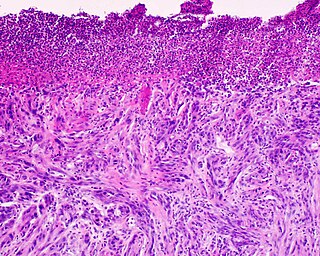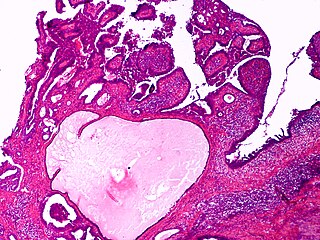Related Research Articles
A skin condition, also known as cutaneous condition, is any medical condition that affects the integumentary system—the organ system that encloses the body and includes skin, hair, nails, and related muscle and glands. The major function of this system is as a barrier against the external environment.

A seborrheic keratosis is a non-cancerous (benign) skin tumour that originates from cells in the outer layer of the skin. Like liver spots, seborrheic keratoses are seen more often as people age.

An epidermoid cyst or epidermal inclusion cyst is a benign cyst usually found on the skin. The cyst develops out of ectodermal tissue. Histologically, it is made of a thin layer of squamous epithelium.

Mucinous carcinoma is a type of cancer that arises from epithelial cells; these line certain internal organs and skin, and produce mucin.
Schöpf–Schulz–Passarge syndrome is an autosomal recessive condition with punctate symmetric palmoplantar keratoderma, with the keratoderma and fragility of the nails beginning around age 12. In addition to palmoplantar keratoderma, other symptoms include hypodontia, hypotrichosis, nail dystrophies, and eyelid cysts. Patients may also develop syringofibroadenoma and squamous cell carcinomas.

Porokeratosis is a specific disorder of keratinization that is characterized histologically by the presence of a cornoid lamella, a thin column of closely stacked, parakeratotic cells extending through the stratum corneum with a thin or absent granular layer.
Eruptive vellus hair cysts are small lesions that occur most often in the chest wall, abdomen and extremities, often with a crusted surface. EVHC may occur randomly, or it can be inherited as an autosomal dominant trait. The condition affects males and females equally, and sporadic cases usually appear at 4–18 years of age. The cysts appear similar clinically to steatocystoma multiplex, as well as acneiform eruptions and milia. Therapeutic techniques that are safe and effective are rare, with incision and drainage being the primary form of treatment when sporadic regression does not occur. It was first described in 1977.
Gonococcemia is a condition characterized by a hemorrhagic vesiculopustular eruption, bouts of fever, and arthralgia or actual arthritis of one or several joints.

Cutaneous lymphoid hyperplasia refers to a groups of benign cutaneous disorders characterized by collections of lymphocytes, macrophages, and dendritic cells in the skin. Conditions included in this groups are:
Idiopathic scrotal calcinosis is a cutaneous condition characterized by calcification of the skin resulting from the deposition of calcium and phosphorus occurring on the scrotum. However, the levels of calcium and phosphate in the blood are normal. Idiopathic scrotal calcinosis typically affects young males, with an onset between adolescence and early adulthood. The scrotal calcinosis appears, without any symptoms, as yellowish nodules that range in size from 1 mm to several centimeters.

Desmoplastic melanoma is a rare cutaneous condition characterized by a deeply infiltrating type of melanoma with an abundance of fibrous matrix. It usually occurs in the head and neck region of older people with sun-damaged skin. Diagnosis can be difficult as it has a similar appearance to sclerosing melanocytic nevi as well as some nonmelanocytic skin lesions such as scars, fibromas, or cysts.

A sebaceous adenoma, a type of adenoma, a cutaneous condition characterized by a slow-growing tumor usually presenting as a pink, flesh-coloured, or yellow papule or nodule.

Spiradenoma, also spiroma or eccrine spiradenoma, is a cutaneous condition that is typically characterized, clinically, as a solitary, deep-seated dermal nodule of approximately one centimeter, occurring on the ventral surface of the body. Spiradenoma lesions are benign sudoriferous tumors, and have also been described as cystic epitheliomas of the sweat glands.

Eccrine carcinoma is a rare skin condition characterized by a plaque or nodule on the scalp, trunk, or extremities. It originates from the eccrine sweat glands of the skin, accounting for less than 0.01% of diagnosed cutaneous malignancies. Eccrine carcinoma tumors are locally aggressive with a high rate of recurrence. Lack of reliable immunohistochemical markers and similarity to other common tumors has made identification of eccrine carcinoma difficult.

Apocrine gland carcinoma is a cutaneous condition characterized by skin lesions which form in the axilla or anogenital regions.

Trichilemmoma is a benign cutaneous neoplasm that shows differentiation toward cells of the outer root sheath. The lesion is often seen in the face and neck region. Multifocal occurrence is associated with Cowden syndrome, in which hamartomatous intestinal polyposis is seen in conjunction with multiple tricholemmoma lesions.

Palisaded encapsulated neuroma (PEN) is a rare, benign cutaneous condition characterized by small, firm, non-pigmented nodules or papules. They typically occur as a solitary (single) lesion near the mucocutaneous junction of the skin of the face, although they can occur elsewhere on the body.
Papillomatosis cutis carcinoides is a cutaneous condition characterized by verrucous skin lesions, and is due to an HPV infection of the skin.
References
- ↑ James, William D.; Berger, Timothy G.; et al. (2006). Andrews' Diseases of the Skin: Clinical Dermatology. Saunders Elsevier. ISBN 0-7216-2921-0.
- ↑ Rapini, Ronald P.; Bolognia, Jean L.; Jorizzo, Joseph L. (2007). Dermatology: 2-Volume Set. St. Louis: Mosby. p. 1710. ISBN 978-1-4160-2999-1.
- ↑ Naylor E, Sarkar P, Perlis CS, Giri D, Gnepp DR, Robinson-Bostom L (April 2008). "Primary cutaneous adenoid cystic carcinoma". J. Am. Acad. Dermatol. 58 (4): 636–41. doi:10.1016/j.jaad.2007.12.005. PMID 18342709.
| This Epidermal nevi, neoplasms, cysts article is a stub. You can help Wikipedia by expanding it. |